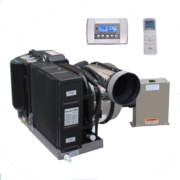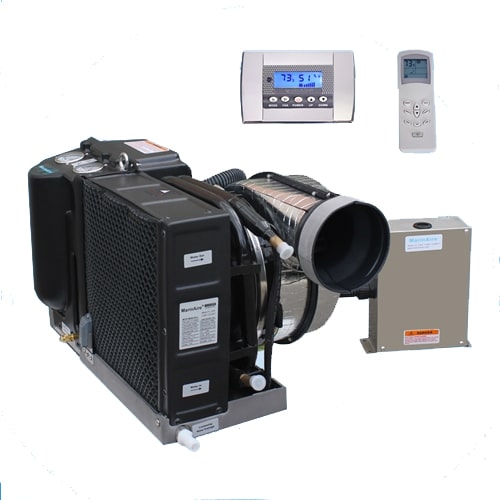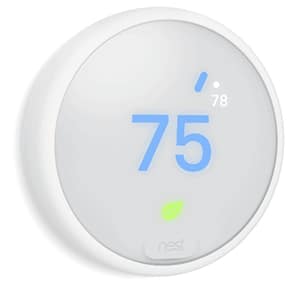Air Conditioning on a Sailboat
Air conditioning is an enormous energy drain.
This is a typical air conditioner installed usually under the settee in a boat.
A typical air conditioner in a boat is rated at 16000 BTU/hr. BTU is a measure of energy also. Therefore BTU/hr is the rate of energy use; power. A BTU is a British Thermal Unit. It is the amount of energy required to raise one pound of water by 1 degree Fahrenheit. Note that people quote the size of an air conditioning system in “BTU” e.g. 8000 BTU is a typical small air conditioning unit – however, they really mean “BTU/hr”. While pounds and Fahrenheit are legacy units in engineering language, the quoted energy usage rate units of BTU/hr (instead of watts) have been able to stay as a standard sizing for air conditioning.
For conversion sake, 1000 BTU/hr is 293.1 watts or 0.2931 kW
and thus a typical Air Conditioner Unit of 16000 BTU/hr is equivalent to 4.7 kW.
This means if you run a 16000 BTU/hr air conditioner for 10 hours through the night, you will use 47 kW.hrs. Compare this to the 4.4 kW.hrs used for all the other energy requirements for a boat. In reality, the air conditioner does not run all night. It operates under the same thermostat principle as a fridge.
To gain a handle on energy usage of an air conditioner, NauticEd conducted a test on a new Beneteau 41 with one 16000 BTU/hr air conditioner and one 8000 BTU/hr air conditioner, with the hatches closed, with water temperature at 80 degrees (26.7 deg C) and night average air temperature of 81 degrees (27.2 deg C)(similar to the Caribbean), and with the thermostat set at 75 degrees F (23.9 deg C).
If both Air Conditioning units were blasting cold air all night on full then you would expect that the following amount of energy would have been used:
24000 BTU/hr is 7 kW.
Running for 10 hours you’d burn 70 kW.hrs
However, the total energy usage was actually 12.7 kW.hrs over 10 hours. Thus the duty cycle was about 20% because hatches were closed and the air conditioner did not have to run all night. That’s the job of the thermostat – it turns off the airconditioner when the lower temperature setting is reached.
There was however no one sleeping on board and so that needs to be factored in. A typical human emits about 100 watts of energy when sleeping. Thus in 10 hours, a human would emit 1kW.hrs of energy. With four people sleeping on board, the total energy drain used by the air conditioner to keep the inside temperate at 75 deg F would have been 16.7 kW.hrs.
Generators are sized on a boat to handle the greatest instantaneous power drain rate which is generally the air conditioning when all units are fully on. In the Beneteau 41 example above, the generator should be sized to handle 24000 BTU/hr or 7 kW. Subsequently, the generator specified on the Beneteau 41 was an 8 kW generator.
You can see that there is a big difference between 7kW times 10 hours (70 kW.hrs) and the actual 16.7 kW.hr used (assuming humans are present). This is because the thermostat kicks on and off. However, if the doors had been left open to the outside all night, the energy used would be closer to the 70kW.hrs. Also, during our experiment, the curtains were drawn and hatches sealed. Thus, it is important to close doors and hatches and night when running the AC and draw curtains for the early morning heat from the sun. Although the generator can handle running the AC at full speed, at least if nothing else, close doors to conserve fuel powering the generator and thus pollution going into the environment as well as reduce the load on the generator so that it requires less maintenance.
Can we have a pet peeve talk? No? Ok, skip this paragraph. Yes? Good! The thermostat is just an on-off setting switch. It tells the air conditioner to turn on above this temperature and to turn off below this temperature (given a slight few degrees buffer). When the temperature is above the thermostat, the air conditioner turns on at full speed and full cooling rate. Thus, turning the thermostat to a colder temperature to get the boat (or house) to cool down faster DOES NOT WORK. All it does is to make the boat colder than the comfortable setting that you want it and waste a lot of energy and fuel. There, it is said.
A more efficient type of air conditioner is called a Variable Frequency Drive. What it does is stay on all the time but only run at very low speeds while constantly monitoring the temperature. It also starts up very slowly so there is never a huge power drain each time it starts up like an older more conventional air conditioner. With a VFD airconditioner, it has been shown that upwards of 40% energy savings can be made. For a boat, this is a must. Unfortunately, some of the larger manufacturers are not using this technology. If you are buying a boat, insist that you get VFD air conditioning units.








